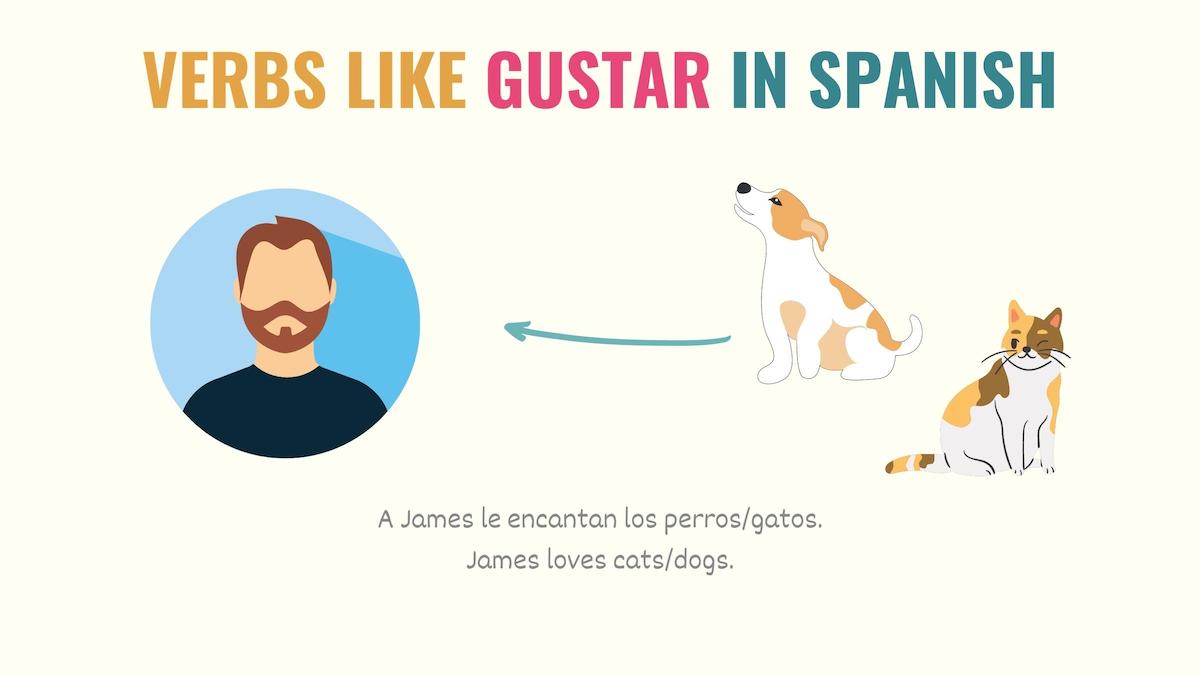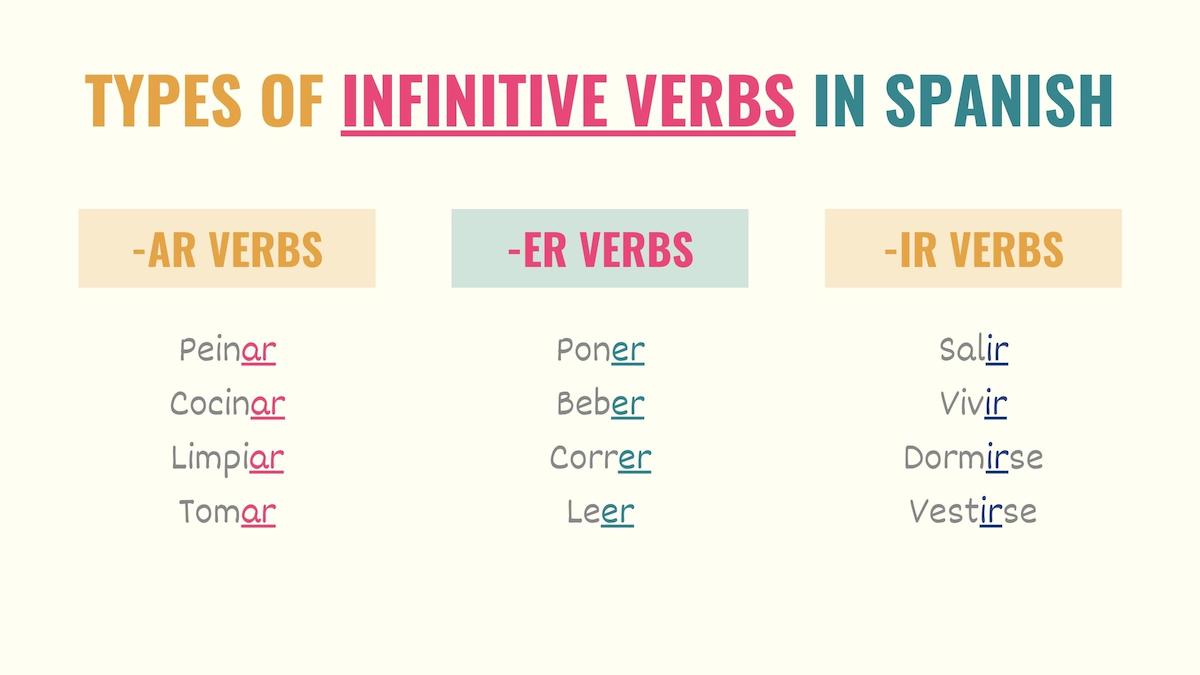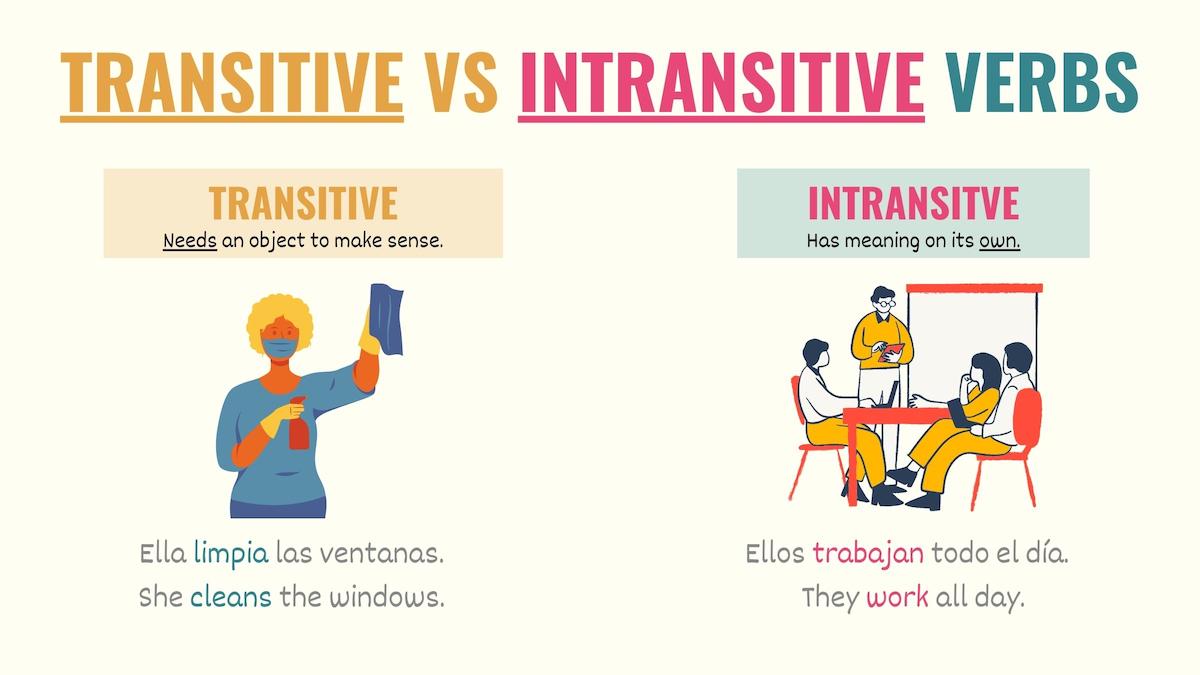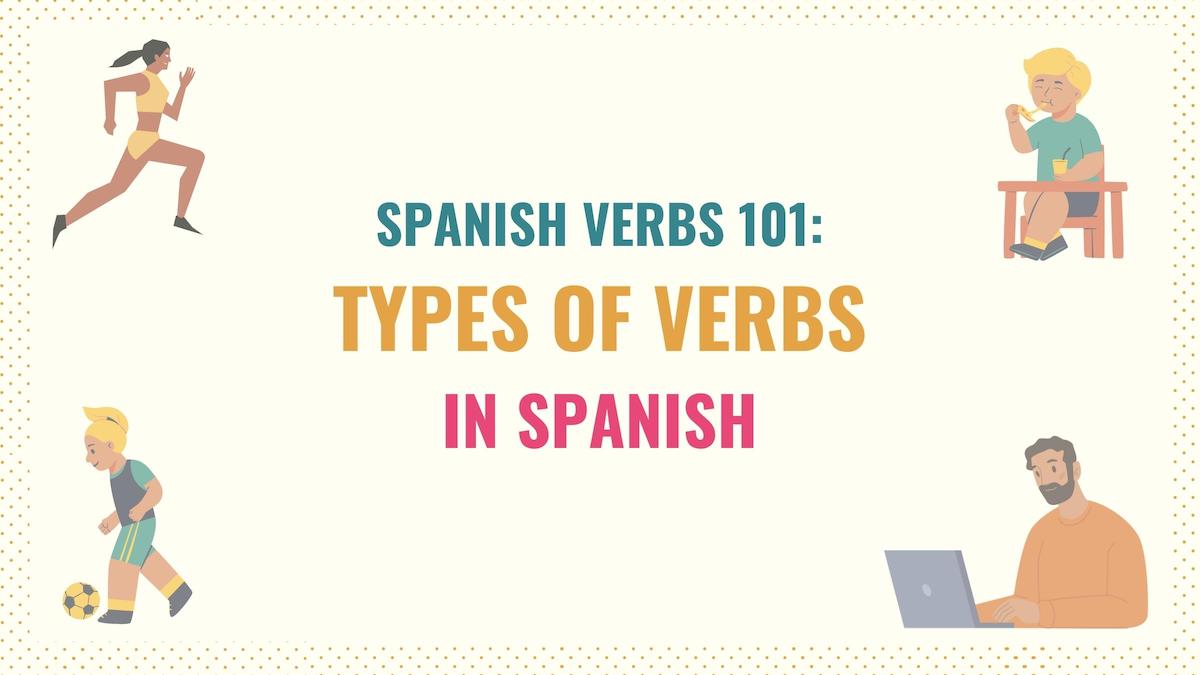Verbs are the part of speech in Spanish that express someone’s action or state of being. Depending on their function in a sentence, there are different types of verbs in Spanish (such as auxiliary, transitive, pronominal etc).
Understanding these qualities can help you use these words more effectively. So, here is an overview of what we’ll cover in this guide:
- Classes of Verbs Based on Their Function
- Types of Verbs Based on Their Conjugation Model
- Additional Resources for Spanish Verbs
Types of Spanish Verbs Based on Their Function
Regardless of their infinitive ending (conjugation group), verbs in Spanish can have different classifications based on the elements they work with or their purpose in the sentence.
So, here are the types of verbs you must know:
Action verbs
Spanish action verbs refer to actions the subject performs or experiences. Because of this, they convey movement or dynamism. Here are some examples of these forms of verbs:
Affective verbs

Affective verbs, commonly known as verbs like gustar, describe the feelings something causes in a person. These are verbs of “indirect object” since they need this element to be complete. Some examples include:
- Aburrir: To bore
- Caer bien: To like (friendly)
- Gustar: To like
- Interesar: To interest
Auxiliary verbs
Auxiliary verbs in Spanish are used to form compound tenses, such as the present progressive or the past perfect tense. Their purpose in a sentence is to convey grammatical information.
Haber, ser, and estar are some of the most common auxiliary verbs.
Impersonal verbs
These are verbs used in sentences without a subject. In other words, when it’s unclear who did the action. In Spanish, impersonal verbs are often related to weather, existence, or to describe a place’s traditions. For instance:
- Hace: It’s
- Hay: There is / There are
- Llover: To rain
Check my guide to impersonal verbs in Spanish to see more examples and contexts where you need to use these types of verbs.
Infinitive verbs

An infinitive is a non-conjugated verb. Simply put, these words still have the endings -AR, -ER, or -IR. Infinitives can be used in verbal phrases, to give impersonal commands, among other things.
Quiero ver esa película.
I want to watch that movie.
¿A qué hora vas a hacer tu tarea?
When are you going to do your homework?
Linking or copular verbs
As its name suggests, linking verbs connects a sentence’s subject with an adjective. These verbs don’t express an action but rather a condition or a state. The verbs ser, parecer and estar are linking verbs.
La niña es bonita.
The girl is pretty.
Ese lugar parece peligroso.
That place seems dangerous.
Past participles
Spanish past participles (verbs ending in -ado or -ido) complete the meaning of an auxiliary verb. If this auxiliary verb is estar, past participles work as adjectives. For instance:
No he comido nada.
I haven’t eaten anything.
Carlos está enojado por lo que le dije.
Carlos is mad about what I said.
Present participles
Present participles in Spanish are the equivalent of -ing words, and they’re used with an auxiliary verb. Here are some sentences:
Estoy viendo la tele.
I’m watching TV.
¿Sigues estudiando?
Are you still studying?
Pronominal verbs
In Spanish, pronominals are verbs that end with the pronoun se. Depending on what they express, these verbs can be classified into:
- Reflexive verbs: to express the subject performs the action upon oneself.
- Reciprocal verbs: to convey that two or more subjects do something to each other.
- Idiomatic: they use reflexive pronouns to maintain a specific meaning.
| Reflexive | Reciprocal | Idiomatic |
|---|---|---|
| Yo me peino. I comb my hair. | Nos gustamos. We like each other. | Me voy en un rato. I am leaving in a few. |
Transitive and intransitive
Verbs in Spanish can be classified into transitive or intransitive based on whether they require a direct object to complete their meaning. Intransitive verbs stand alone in a sentence:
Ella trabaja aquí.
She works here.
But, a transitive verb needs a direct object to have full meaning:
Ella compró una bolsa.
She bought a bag.

Take Note: Transitive verbs work with direct object pronouns. So, check this guide to make sure you understand how these types of verbs work.
Spanish Verb Conjugation: Verb Ending
Spanish verbs can also be classified based on their infinitive ending, which will indicate the conjugation group they belong to:
- -AR verbs: bañar, bailar, cantar, etc.
- -ER verbs: tener, comer, beber, etc.
- -IR verbs: dormir, salir, vivir, etc.
Depending on the conjugation pattern they follow, verbs can be:
Regular if their root doesn’t change, and you must only add the corresponding tense ending. Some common regular verbs in Spanish are:
- Amar: To love
- Bañar: To shower / To bath
- Correr: To run
- Perdonar: To forgive
- Vivir: To live
On the other hand, irregular Spanish verbs have a dramatic change in their root, and in some tenses, you must use specific endings. Some basic irregular verbs are:
Finally, stem-changing verbs in Spanish modify consonants and vowels in their root. These changes are made to maintain the pronunciation. Some examples of these verbs are:
Take Note: There are different spelling rules to remember regarding stem-changing verbs. So, make sure you understand how they work.
Next Steps: Spanish Verbs-Related Resources
Verbs are a pivotal part of a Spanish sentence. So, here are some additional articles that can help you with this topic. One of the most common mistakes people make with these types of words is mixing their conjugation. As a result, you want to ensure that you know how to conjugate verbs in Spanish.
Also, you should familiarize yourself with the endings you must use for different Spanish tenses and the most common verbs we use in daily conversations.
Download the types of verbs PDF cheat sheet
Understanding the different functions of a verb can be challenging. However, this can help you identify and avoid common mistakes in Spanish. So, I’ve compiled a free PDF on the different types of verbs. You can use it to review this information whenever you need it.





